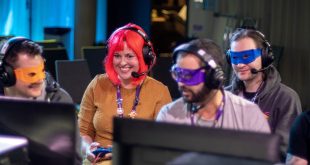Every month an industry leader wraps up MCV/DEVELOP with their unique insight. This month, we speak to Colin Urquhart, CEO and co-founder of DI4D.
 Colin Urquhart is a thirty year industry veteran and innovator in the field of facial capture and animation. The DI4D team has worked on a host of leading entertainment projects, including Blade Runner 2049, Call of Duty: Modern Warfare, Love, Death and Robots, and Quantum Break.
Colin Urquhart is a thirty year industry veteran and innovator in the field of facial capture and animation. The DI4D team has worked on a host of leading entertainment projects, including Blade Runner 2049, Call of Duty: Modern Warfare, Love, Death and Robots, and Quantum Break.
What has been a memorable highlight of your career?
One of the most memorable projects for me has been La Belle et la Bête, the 2014 French-language version of Beauty and the Beast. This was one of the first projects using our DI4D PRO system capturing the facial performance of Vincent Cassel as the Beast. The DI4D PRO system, with its relatively constrained head position was setup inside an ADR booth; so it was not an environment particularly conducive to good acting. Nevertheless, it was remarkable to witness Vincent delivering such nuanced and convincing facial performances as the Beast. Since then, our guiding principle is recognising the value of good performance under good direction and reproducing that as faithfully as possible onto a digital character.
What would you say is your most outstanding achievement?
Processing all of the facial performance data for Activision’s new Call of Duty: Modern Warfare II is our most outstanding achievement to date. It represents the culmination of all the technological advancements that have gone into the development of our PURE4D solution. It has been fantastic to see how faithfully these performances have been reproduced on their in-game digital double characters.
Would you say the industry is in a good place at the moment?
I would say that the games industry is in a really good place. In contrast to the movie industry, its growth has actually accelerated over the pandemic, while people have been more likely to stay at home. The introduction of the new generation of consoles has also stimulated innovation and an increased willingness to try new approaches, leading to an extra level of vibrancy. The trend for more narrative-focused games such as Supermassive Games’ The Quarry, which blur the lines between “traditional” narrative and gaming content is particularly exciting.
What are the gaming industry’s biggest challenges in the years ahead?
One of the biggest challenges faced by the industry is continuing to create content that is sufficiently detailed and realistic to match the increasing graphical power of gaming hardware. As a result, capturing content from real life sources is becoming increasingly preferred to creating it artistically. 3D scanning of real life people is now used routinely to create digital doubles for video game characters. Motion capture is the standard method of obtaining body animation. Creating sufficiently realistic facial animation at video game scale increasingly requires the use of solutions like PURE4D to accurately capture an actor’s facial performance and then apply it faithfully to their digital double.

 MCV/DEVELOP News, events, research and jobs from the games industry
MCV/DEVELOP News, events, research and jobs from the games industry




